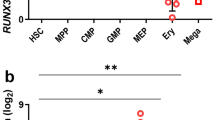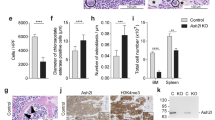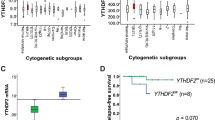Abstract
The transcription factor hypoxia inducible factor 1 (HIF1), an HIF1α–aryl hydrocarbon receptor nuclear translocator (ARNT) dimeric factor, is essential to the cellular response to hypoxia. We described a t(1;12)(q21;p13) chromosomal translocation in human acute myeloblastic leukemia that involves the translocated Ets leukemia (TEL/ETV6) and the ARNT genes and results in the expression of a TEL-ARNT fusion protein. Functional studies show that TEL-ARNT interacts with HIF1α and the complex binds to consensus hypoxia response element. In low oxygen tension conditions, the HIF1α/TEL-ARNT complex does not activate transcription but exerts a dominant-negative effect on normal HIF1 activity. Differentiation of normal human CD34+ progenitors cells along all the erythrocytic, megakaryocytic and granulocytic pathways was accelerated in low versus high oxygen tension conditions. Murine 32Dcl3 myeloid cells also show accelerated granulocytic differentiation in low oxygen tension in response to granulocyte colony-stimulating factor. Interestingly, stable expression of the TEL-ARNT in 32Dcl3 subclones resulted in impaired HIF1-mediated transcriptional response and inhibition of differentiation enhancement in hypoxic conditions. Taken together, our results underscore the role of oxygen tension in the modulation of normal hematopoietic differentiation, whose targeting can participate in human malignancies.
This is a preview of subscription content, access via your institution
Access options
Subscribe to this journal
Receive 50 print issues and online access
$259.00 per year
only $5.18 per issue
Buy this article
- Purchase on Springer Link
- Instant access to full article PDF
Prices may be subject to local taxes which are calculated during checkout




Similar content being viewed by others
References
Acker T, Diez-Juan A, Aragones J, Tjwa M, Brusselmans K, Moons L et al. (2005). Cancer Cell 8: 131–141.
Adelman DM, Maltepe E, Simon MC . (1999). Genes Dev 13: 2478–2483.
An WG, Kanekal M, Simon MC, Maltepe E, Blagosklonny MV, Neckers LM . (1998). Nature 392: 405–408.
Baudino TA, McKay C, Pendeville-Samain H, Nilsson JA, Maclean KH, White EL et al. (2002). Genes Dev 16: 2530–2543.
Ciofani M, Zuniga-Pflucker JC . (2005). Nat Immunol 6: 881–888.
Dang CV, Semenza GL . (1999). Trends Biochem Sci 24: 68–72.
Fenrick R, Amann JM, Lutterbach B, Wang L, Westendorf JJ, Downing JR et al. (1999). Mol Cell Biol 19: 6566–6574.
Forsythe JA, Jiang BH, Iyer NV, Agani F, Leung SW, Koos RD et al. (1996). Mol Cell Biol 16: 4604–4613.
Fukuda R, Hirota K, Fan F, Jung YD, Ellis LM, Semenza GL . (2002). J Biol Chem 277: 38205–38211.
Golub T, Goga A, Barker G, Afar D, McLaughlin L, Bohlander S et al. (1996). Mol Cell Biol 16: 4107–4116.
Golub TR, Barker GF, Lovett M, Gilliland DG . (1994). Cell 77: 307–316.
Graeber TG, Osmanian C, Jacks T, Housman DE, Koch CJ, Lowe SW et al. (1996). Nature 379: 88–91.
Gustafsson MV, Zheng X, Pereira T, Gradin K, Jin S, Lundkvist J et al. (2005). Dev Cell 9: 617–628.
Harris AL . (2002). Nat Rev Cancer 2: 38–47.
Hiebert SW, Sun W, Davis JN, Golub T, Shurtleff S, Buijs A et al. (1996). Mol Cell Biol 16: 1349–1355.
Hoffman EC, Reyes H, Chu FF, Sander F, Conley LH, Brooks BA et al. (1991). Science 252: 954–958.
Huang LE, Arany Z, Livingston DM, Bunn HF . (1996). J Biol Chem 271: 32253–32259.
Iyer NV, Kotch LE, Agani F, Leung SW, Laughner E, Wenger RH et al. (1998). Genes Dev 12: 149–162.
Jiang Y, Xue ZH, Shen WZ, Du KM, Yan H, Yu Y et al. (2005). Leukemia 19: 1239.
Jousset C, Carron C, Boureux A, Quang CT, Oury C, Dusanter-Fourt I et al. (1997). EMBO J 16: 69–82.
Kim CA, Phillips ML, Kim W, Gingery M, Tran HH, Robinson MA et al. (2001). EMBO J 20: 4173–4182.
Kline DD, Peng YJ, Manalo DJ, Semenza GL, Prabhakar NR . (2002). Proc Natl Acad Sci USA 99: 821–826.
Kojima H, Gu H, Nomura S, Caldwell CC, Kobata T, Carmeliet P et al. (2002). Proc Natl Acad Sci USA 99: 2170–2174.
Kotch LE, Iyer NV, Laughner E, Semenza GL . (1999). Dev Biol 209: 254–267.
Kroon ME, Koolwijk P, van der Vecht B, van Hinsbergh VW . (2001). J Cell Sci 114: 825–833.
Lacaud G, Gore L, Kennedy M, Kouskoff V, Kingsley P, Hogan C et al. (2002). Blood 100: 458–466.
Lacronique V, Boureux A, Valle VD, Poirel H, Quang CT, Mauchauffe M et al. (1997). Science 278: 1309–1312.
Li J, Shworak NW, Simons M . (2002). J Cell Sci 115: 1951–1959.
Linggi B, Muller-Tidow C, van de Locht L, Hu M, Nip J, Serve H et al. (2002). Nat Med 8: 743–750.
Liu W, Guo M, Xu Y-B, Li D, Zhou Z-N, Wu Y-L et al. (2006). Blood 107: 698–707.
Lopez RG, Carron C, Oury C, Gardellin P, Bernard O, Ghysdael J . (1999). J Biol Chem 274: 30132–30138.
Maltepe E, Schmidt JV, Baunoch D, Bradfield CA, Simon MC . (1997). Nature 386: 403–407.
Maxwell PH, Pugh CW, Ratcliffe PJ . (2001). Curr Opin Genet Dev 11: 293–299.
Poirel H, Oury C, Carron C, Duprez E, Laabi Y, Tsapis A et al. (1997). Oncogene 14: 349–357.
Ramirez-Bergeron DL, Runge A, Dahl KD, Fehling HJ, Keller G, Simon MC . (2004). Development 131: 4623–4634.
Rubnitz JE, Pui CH, Downing JR . (1999). Leukemia 13: 6–13.
Ryan HE, Lo J, Johnson RS . (1998). EMBO J 17: 3005–3015.
Safran M, Kaelin Jr WG . (2003). J Clin Invest 111: 779–783.
Salomon-Nguyen F, Della-Valle V, Mauchauffe M, Busson-Le Coniat M, Ghysdael J, Berger R et al. (2000). Proc Natl Acad Sci USA 97: 6757–6762.
Semenza GL . (2000). Genes Dev 14: 1983–1991.
Speck NA . (2001). Curr Opin Hematol 8: 192–196.
Vander Heiden MG, Plas DR, Rathmell JC, Fox CJ, Harris MH, Thompson CB . (2001). Mol Cell Biol 21: 5899–5912.
Wang GL, Jiang BH, Rue EA, Semenza GL . (1995). Proc Natl Acad Sci USA 92: 5510–5514.
Zelzer E, Glotzer DJ, Hartmann C, Thomas D, Fukai N, Soker S et al. (2001). Mech Dev 106: 97–106.
Zelzer E, Levy Y, Kahana C, Shilo BZ, Rubinstein M, Cohen B . (1998). EMBO J 17: 5085–5094.
Acknowledgements
This work was partly supported by INSERM, Association Contre le Cancer (ARC), Fondation pour la Recherche Médicale (FRM), Ligue Nationale Contre le Cancer (LNCC), Comité national and Comité de Paris (JG and OAB are équipes labellisées LNCC). We thank D Brugnon and P Puech for skillful help in FACS analyses, A Yoshimura for the Myc tag, A Kung for discussion, M Vekemans for help in improving the manuscript and R Berger for constant support.
Author information
Authors and Affiliations
Corresponding author
Additional information
Supplementary Information accompanies the paper on Oncogene website (http://www.nature.com/onc).
Rights and permissions
About this article
Cite this article
Nguyen-Khac, F., Della Valle, V., Lopez, R. et al. Functional analyses of the TEL-ARNT fusion protein underscores a role for oxygen tension in hematopoietic cellular differentiation. Oncogene 25, 4840–4847 (2006). https://doi.org/10.1038/sj.onc.1209503
Received:
Revised:
Accepted:
Published:
Issue Date:
DOI: https://doi.org/10.1038/sj.onc.1209503
Keywords
This article is cited by
-
Sumoylation of hypoxia inducible factor-1α and its significance in cancer
Science China Life Sciences (2014)
-
HIF-1α downregulates miR-17/20a directly targeting p21 and STAT3: a role in myeloid leukemic cell differentiation
Cell Death & Differentiation (2013)
-
Very low oxygen concentration (0.1%) reveals two FDCP-Mix cell subpopulations that differ by their cell cycling, differentiation and p27KIP1 expression
Cell Death & Differentiation (2011)
-
Hypoxia-inducible factor-1α-induced differentiation of myeloid leukemic cells is its transcriptional activity independent
Oncogene (2008)
-
Physical and functional interaction of Runt-related protein 1 with hypoxia-inducible factor-1α
Oncogene (2008)



